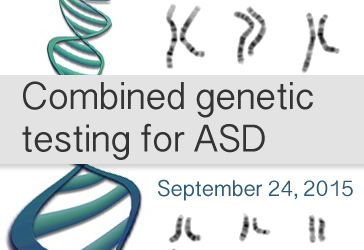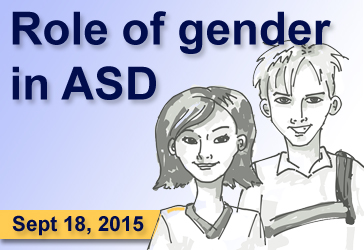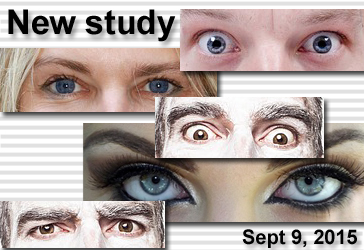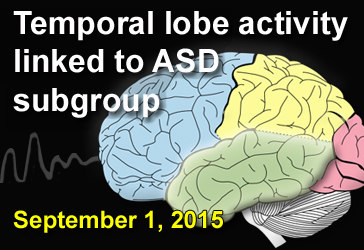Archives
September, 2015
Select a different month in the archive
Combined Genetic Tests May Improve ASD Management
By Chelsea E. Toledo, M.A. on September 24, 2015

Background: Autism spectrum disorder (ASD) is thought to be caused by a combination of genetic and environmental factors. To date, variations in hundreds of genes have been associated with ASD, and these explain only a small fraction of individuals with autism. Although no genetic tests are available for the diagnosis of ASD, genetic testing could offer guidance for medical management. Some tests look for big changes in DNA, while others check for small variations.
What’s New: On September 1, 2015, the Journal of the American Medical Association published a study exploring the utility of combining two genetic tests. The researchers administered chromosomal microarray analysis (CMA) – which identifies large genetic abnormalities, such chunks of missing DNA – to 258 unrelated children with an ASD diagnosis. They then applied whole-exome sequencing (WES) – which helps to identify variations in the protein encoding portions of DNA – to 95 of those children, who also had physical abnormalities sometimes associated with the disorder. They found that, individually, those tests could reveal information about a child’s susceptibility to ASD about eight percent of the time. However, when applied together in children with physical abnormalities, CMA and WES were able to provide an informative diagnosis 38 percent of the time.
Why it’s important: While still not precise enough to provide an initial ASD diagnosis, genetic tests can be useful in informing ASD medical management. Autism-linked genetic variations might predispose a child to other medical conditions, and when combined, CMA and WES could help care providers identify what comorbid conditions to prepare for.
Help me understand :
| Source(s) : |
| Tweet |
Repetitive Behavior Less Severe in Girls with ASD
By Shana R. Spindler, PhD on September 18, 2015

Background: The core symptoms of Autism Spectrum Disorder (ASD) include social differences, communication difficulties, and restricted or repetitive behaviors. While ASD is four times more common in boys than in girls, the cause of this gender gap is unclear. Research studies are being conducted to investigate gender differences in ASD.
What’s new: In a large study of ASD core symptom severity in boys and girls, Stanford University School of Medicine researchers report that girls with ASD have fewer repetitive behaviors than boys on the spectrum. The study, published in the journal Molecular Autism, looked at ASD symptom severity using two well-established datasets of children with ASD. In both datasets, the researchers found that girls scored better than boys on measures of restrictive and repetitive behaviors, with no difference between social and communication function reported.
Brain imaging data for 25 boys and 25 girls with ASD from one of the datasets showed differences in grey matter volume in motor-related and social brain areas. The researchers did not find the same gender differences in grey matter volume between neurotypical boys and girls.
Why it’s important: Examination of ASD core symptom severity in boys and girls may offer clues about ASD risk factors in each gender—such as brain areas sensitive to environmental or genetic stressors. The current study included children with high-functioning ASD only. Additional studies that test these findings in children from a wider range of the spectrum are needed.
Help me understand :
| Source(s) : |
| Tweet |
Face-Reading Study Supports “Extreme Male” Theory
By Chelsea E. Toledo, M.A. on September 9, 2015

Background: Autism spectrum disorder (ASD) is four times more common in boys than in girls. That trend has led some researchers to subscribe to the “extreme male theory” – that the brain of a person with the disorder is essentially an extreme version of male brain in terms of its structure and function.
What’s new: On August 27, 2015, the journal PLoS ONE published a study exploring sex differences when it comes to interpreting facial expressions. The researchers administered an existing online test – called “Reading the Mind in the Eyes” – to a total of 715 adults at an average age of 39. The scores of 152 men and 168 women with typical development followed the previously established trend: women scored better at the task of choosing the correct emotion to match a given facial expression. However, the scores of the 178 men and 217 women with ASD were nearly identical – and much lower across the board than those of their typically developing peers.
Why it’s important: While the “Reading the Mind in the Eyes” test has been used in hundreds of studies since its development in 1997, this is the largest study to administer the test to people with ASD. Future studies could reveal more about the underlying causes of ASD by delving deeper into the sex-common and sex-specific features of ASD.
Help me understand :
| Source(s) : |
| Tweet |
Regressive ASD Linked to Temporal Lobe Activity
By Chelsea E. Toledo, M.A. on September 1, 2015

Background: The temporal lobe, one of the four major parts of the brain’s cerebral cortex, aids in processing sound, categorizing objects, and consolidating memories. It also plays a role in visual processing, emotions, and language. Researchers first began to suspect a relationship between temporal lobe abnormalities and autism spectrum disorder (ASD) in 1975. (see second Pubmed link below)
What’s New: On July 30, 2015, the journal European Child & Adolescent Psychiatry published a study investigating if irregular electrical brain activity – an indicator of epilepsy – could predict any specific feature of ASD. The researchers analyzed the results of brain scans from 220 children and young adults, 71 with ASD and 146 with other developmental disorders. After performing brain measurements on a subgroup of participants, they found a correlation between abnormal electrical brain activity, relatively large head size, and loss of previously acquired developmental skills, known as regression. The relationship between regression and abnormal electrical brain activity was the strongest when that activity took place in the temporal lobe.
Why it’s important: The results of this study support the possibility that irregular electrical activity in distinct brain areas may predict or help define ASD subgroups.
Help me understand :
| Source(s) : |
| Tweet |

